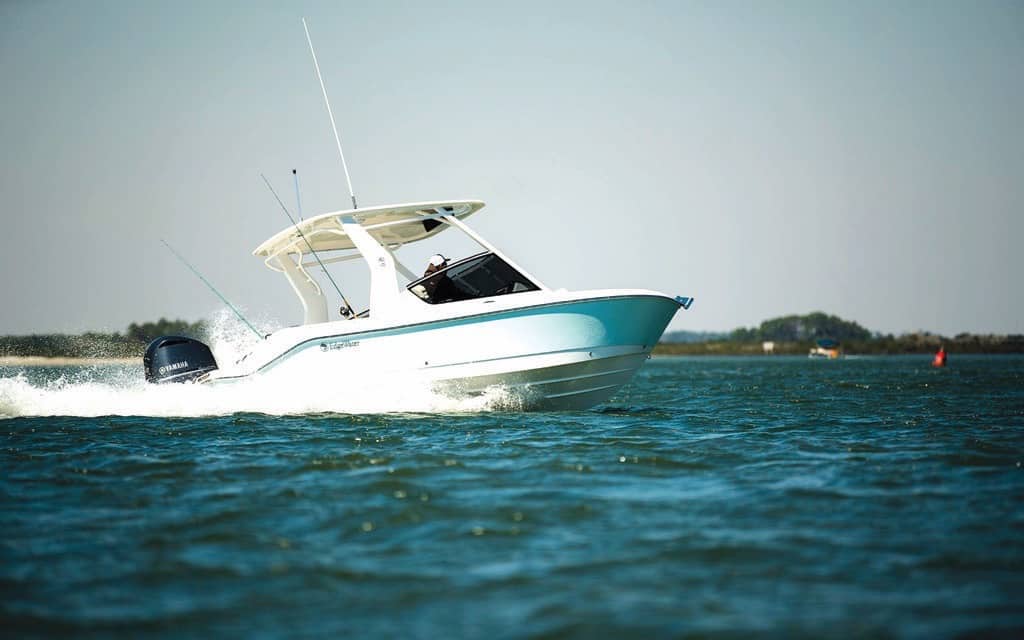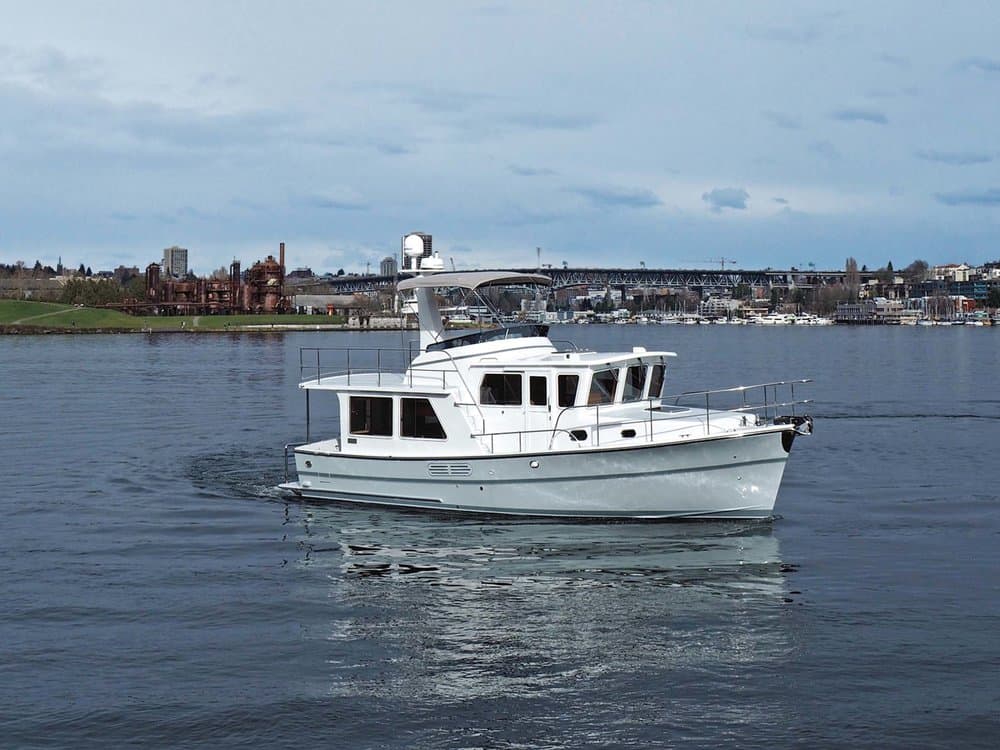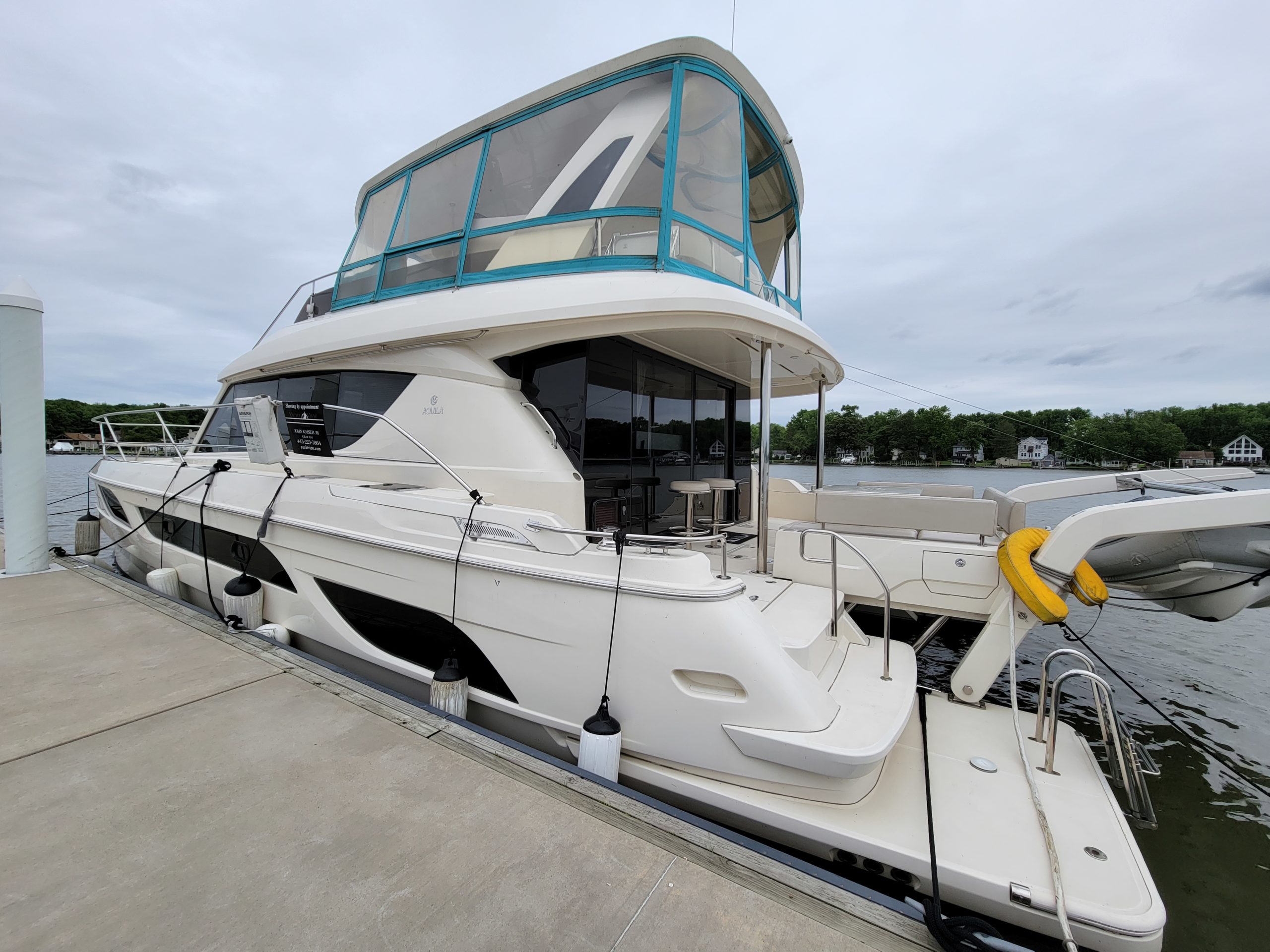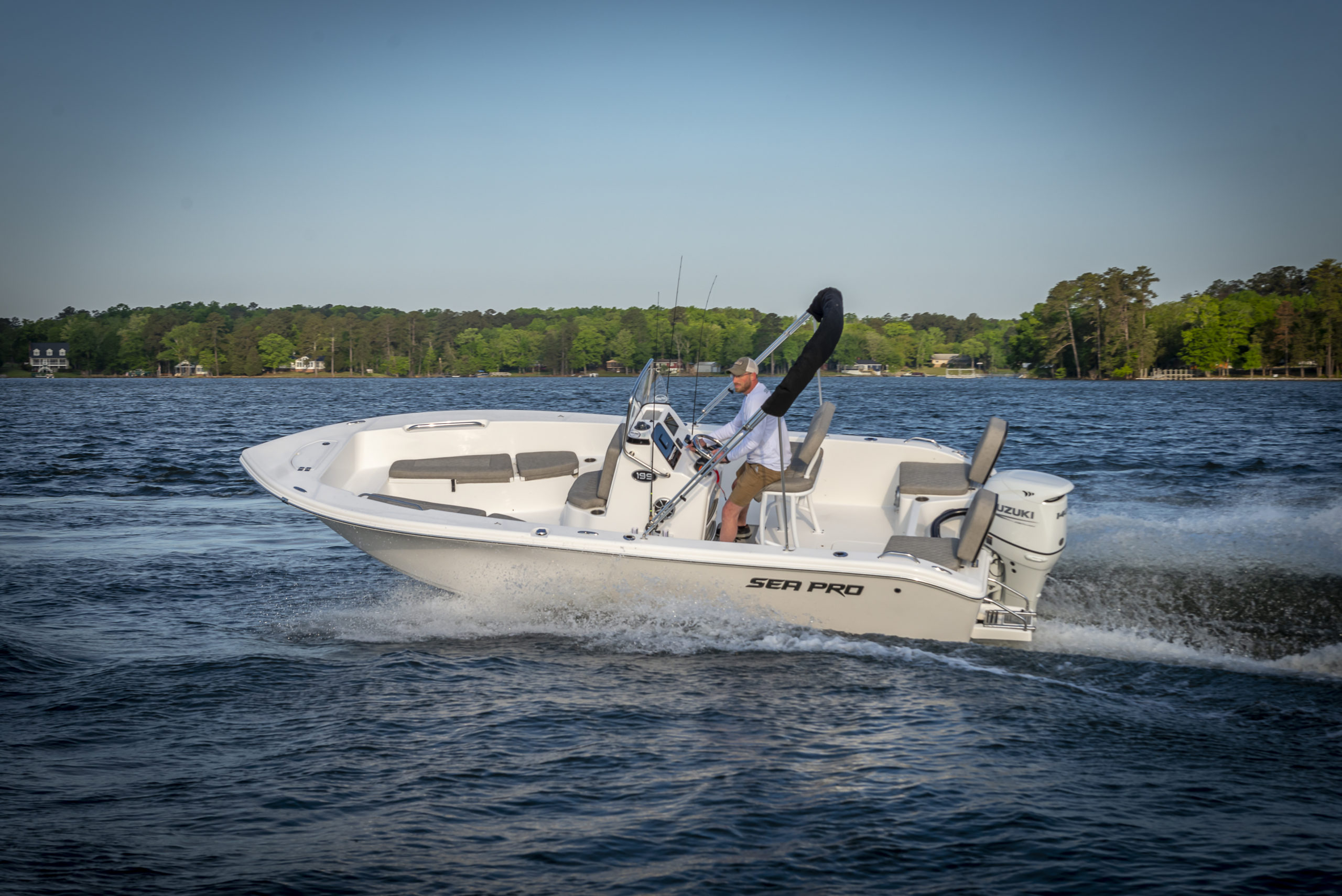The EdgeWater 230CX makes it all work in a handy package.
It’s always easier to up-size than to down-size. When a boat company develops a successful and feature-rich new model, it often spawns larger siblings that hold more people or stuff. Reversing direction and packing those attractive, bigger boat features into a smaller hull is like squeezing a quart into a pint pot. At a certain point, the smaller spaces don’t fit real people anymore.
Despite those odds, EdgeWater Boats has pulled off the feat with its new 230CX (crossover). The first member of this multi-purpose, dual-console line was the single-engine 245CX, introduced ten years ago to provide a seaworthy platform for family activities and serious angling on inland and near-coastal waters. Engineering improvements led to the upgraded 248CX, followed by the twin-engine 262CX and 280CX, all of which have been well-received. We’ve been fans of these well-built, able vessels, but we admit to initial skepticism about the downsized 230CX, until we had a chance to crawl around one and take a thorough test trip. We came away impressed with this little sister’s capabilities.
In the first place, EdgeWater’s “Single-Piece Infusion” composite construction system produces a one-piece, foam-filled, unsinkable hull of great strength that carries a limited lifetime warranty. The twenty-eight-year-old company is known for excellent workmanship, which is evident in top-quality wiring, plumbing, and mechanical systems laid out with access for maintenance. EdgeWater’s proven variable-deadrise deep-V running surface with wide chines provides ample stability and dry running.
EdgeWater’s experience with the larger CX crossovers shows in the 230’s layout. The most obvious feature is the hardtop, with its powder-coated frame, six-foot six-inch headroom, spreader lights, and an electronics box. It covers most of the cockpit for shade, and curtains are available for weather protection, allowing for three-season boating on the Chesapeake. The wraparound windshield mounts in a sturdy frame with a hinged center panel that opens for access to the bow but closes tight for nasty weather, complemented by a swinging panel below. The bow compartment can function as a comfortable lounge for two with armrests and cupholders, a picnic space for four, with a removable table, which stows away in the port console; or as a casting area for an angler working breaking fish. Our test boat had an anchor windlass installed at the bow, but on a boat this size, a manual system would be adequate for most needs.
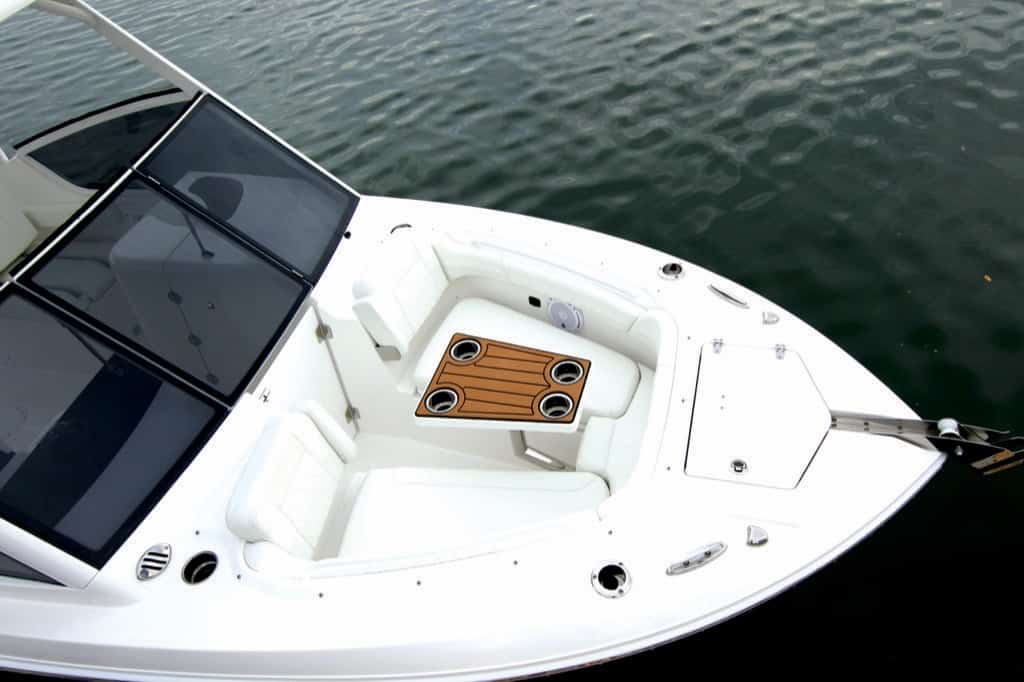
The starboard helm is built for comfort, with an adjustable chair that offers a flip-up bolster for leaning, good sightlines both below and above the windshield, a footrest, and a dash large enough to flush-mount a 12-inch multifunction electronic display (interfaced with a VHF overhead) and a multifunction Yamaha engine display. Behind the side-mounted throttle/shift lever is an open storage compartment for phone and sunglasses. And yes, there’s a cupholder recessed beside the stainless helm. There’s ample storage inside the helm console, and under the helm seat. Immediately aft of the helm seat is a sink with a cutting board cover, over a carry-aboard cooler that slides out on a stainless track for access. There’s a grab bar securely mounted on the back of the sink.
The port console area opens up to the acid test for downsizing—a nicely finished head with a more than adequate 47-inches of headroom). A portable toilet with pumpout is standard. An electric unit and holding tank is optional. The door is shaped for easy backing-in, with a handle placed strategically below the side windshield for steadiness. The space offers natural light and ventilation along with other appointments. The port companion seat functions back-to-back for two passengers or folded down for one. There’s open storage for phone and such, another cupholder, and a slide-out storage drawer there as well. Between the helm and companion seat, there is a long, in-sole storage compartment for skis, boards, and tow toys. The boat’s two batteries are readily accessible, secured on shelves on either side of the space.
A wide seat across the port and center transom accommodates three, with a sturdy, latched door to starboard along with a bib for the raw water washdown system. Below the seat is a livewell and a wide storage compartment below. The back of the transom seat includes four vertical fishing rod holders and a neat retractable tow-sport post.
The afterdeck is well-designed for swimming and handling fish, and it includes non-skid extensions on either side of the engine. To starboard is a retractable boarding ladder, and to port is a shallow compartment for a small stern “lunch hook” anchor or a pair of fins and a mask. There’s another livewell in the port quarter of the transom. The aft gunwales feature ingenious cup/rodholder mounts. Remarkably, there is a horizontal rack for three rods up to 9 feet long (yes, we measured) recessed into the starboard side of the cockpit. The fit and finish for all of these elements is up to EdgeWater’s high standard.
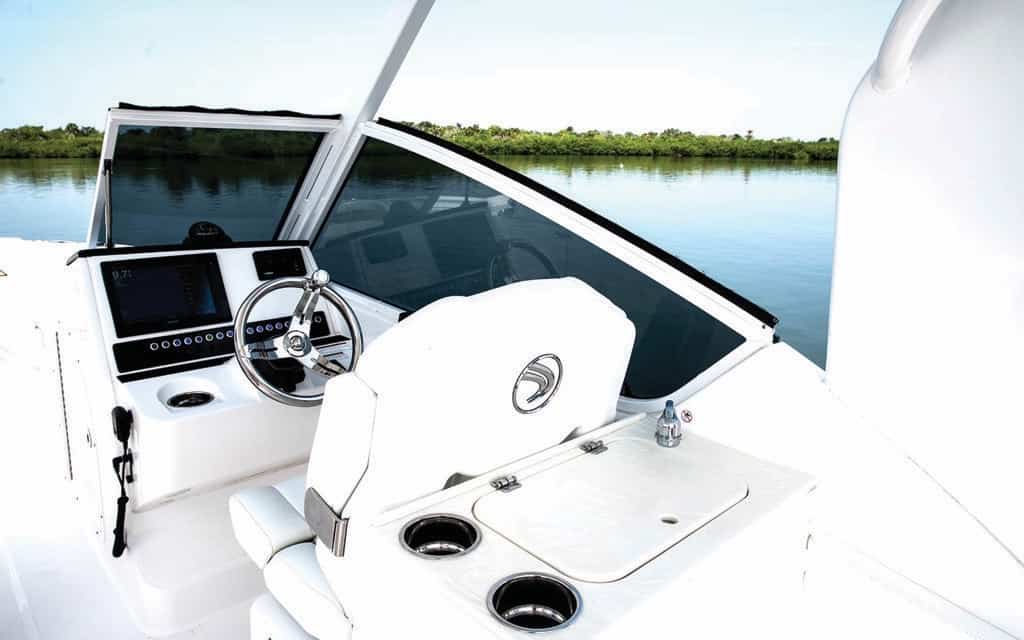
So, what can a family do with a 230CX? Answer: day-cruise in comfort, swim, tow skiers, wakeboards and tubes, and fish in most of the ways appropriate to the Chesapeake and its rivers. The hull inspires confidence. It’s strong and able enough to handle the Bay’s inevitable chop. Standard power is a Yamaha 250. The optional 300 that powered our tester is a splendid, durable engine that pushed the two of us aboard to a top speed of 40 knots. The most efficient cruising speeds were 20 to 25 knots. The 300 offers plenty of power for carrying people and their gear, as well as towing. The 230CX comes up onto plane easily without excessive bow rise, especially if the skipper is handy with engine trim and the hull’s recessed, electric trim tabs.
This size of boat tows easily on a dual-axle trailer behind a full-sized SUV. An adventurous family, or couple, could explore all sorts of Chesapeake waters aboard a 230CX, and with reasonable care, the rig is built well enough to become an heirloom. EdgeWater’s designers and engineers surely got the ergonomics right.
The base price with a Yamaha F300 is $130,095. The sticker on our test boat was $146,054, including options such as an electric head with holding tank, a stereo upgrade, and an anchor windlass, along with freight and dealer prep.

